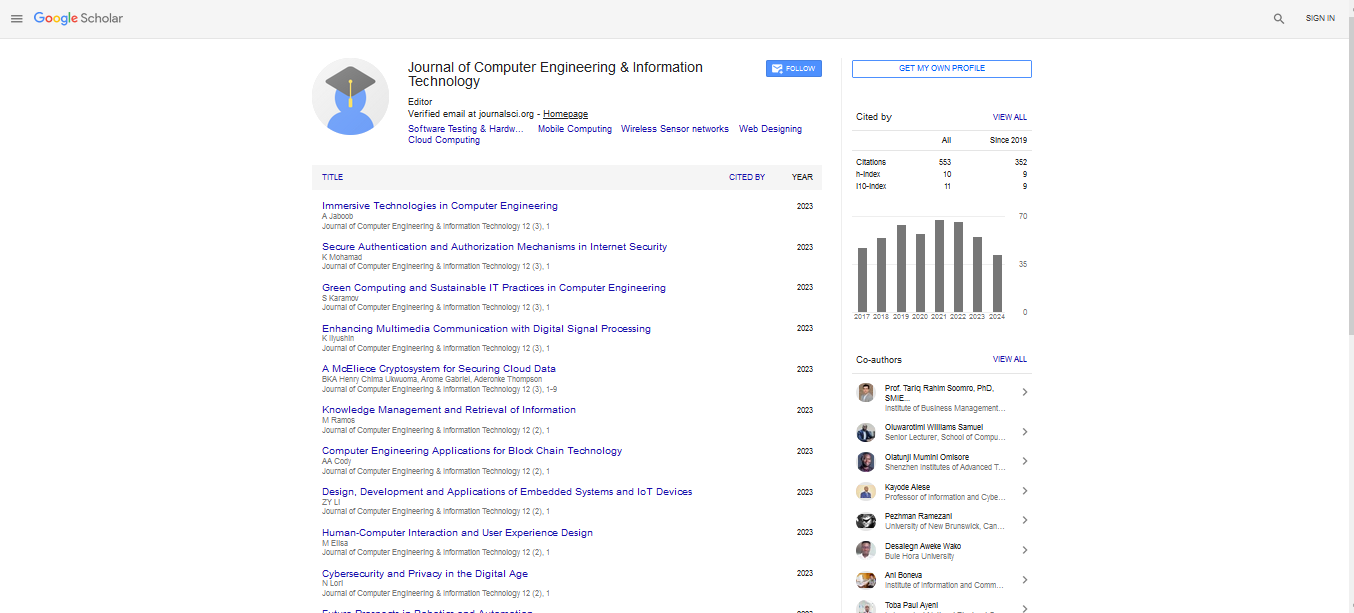Short Communication, J Comput Eng Inf Technol Vol: 6 Issue: 5
How Thermodynamics and Quantum Mechanics Limit Electronic Computation?
Fayez Fok Al Adeh*
The Syrian Cosmological Society, Damascus, Syria
*Corresponding Author : Fayez Fok Al Adeh
President of The Syrian Cosmological Society, Damascus, Syria
Tel: 00963112776729
E-mail: hayfa@scs-net.org
Received: March 28, 2017 Accepted: July 07, 2017 Published: July 12, 2017
Citation: Adeh FFA(2017) How Thermodynamics and Quantum Mechanics Limit Electronic Computation?. Vegetos 6:5. doi: 10.4172/2324-9307.1000182
Abstract
In this communication new concept like the degree of assignment, the mass specific degree of assignment and a dynamic computer were introduced using concepts like second law of thermodynamics, Heisenberg’s uncertainty principle and entropy. The result formulated asserts that electronic computations are not out of the grasp of the second law of thermodynamics. Using Heisenberg’s uncertainty principle it is concluded that the total mass equivalent of the energy that is invested in signals communicating different elements of the computer cannot exceed the total mass of the system. While discussing quantum mechanical description main properties of algorithms and floating point numbers were used to provide a reasonable argument in favor of the wave interpretation of quantum mechanics as compared with other interpretations of quantum mechanics.
Keywords: Second law of thermodynamics; Heisenberg’s uncertainty principle; Entropy; Quantum mechanical description; Floating point numbers
Introduction
The second law of thermodynamics is a universal law. The galactic spiral structures, for example, arise in response to the interaction of that law and the law of gravitation [1,2]. The second law of thermodynamic states that some forms of transformation of one kind of energy to another do not occur in natural processes [3] another profound principle of nature is worth mentioning here. The Heisenberg’s uncertainty principle asserts that nature forbids knowledge beyond a certain limit. The equivalence of entropy and information means that new information is obtained at the price of increased entropy (in a different part of the system). More accuracy means an increase of local information content and a corresponding decrease in local entropy. This is balanced by a parallel increase in global entropy. I introduced new concepts like the degree of assignment, the mass specific degree of assignment, or the mass specific number of distinguishable messages and a dynamic computer. Using these and other concepts, I deduced a relation between the entropic properties of the computer memory (i.e., its macroscopic disorder properties). The result formulated asserts that electronic computations are not out of the grasp of the second law of thermodynamics. A computer is only a limited ordering machine [4]. Increasing its ordering tasks without bounds is impossible, for such an increase will end sooner or later in macroscopic disorder and chaos.
Using Heisenberg’s uncertainty principle [5,6]. I arrived at the conclusion that the total mass equivalent of the energy that is invested in signals communicating different elements of the computer cannot exceed the total mass of the system.
No closed computer system, however constructed, can run programs of infinite lengths (practically very long programs) [7].
In discussing quantum mechanical description [8] I made use of the main properties of algorithms [9,10] and floating point numbers [11] and hence provide a reasonable argument in favor of the wave interpretation of quantum mechanics as compared with other interpretations of quantum mechanics [12-14].
References
- Shu F (1982) The Physical Universe, An Introduction to Astronomy. California: University Science Books, Mill Valley, USA.
- Stonier T (1990) Information and the Internal Structure of the Universe. Springer-Verlag.Berlin, Germany .
- Feynman R, Leighton R, Sands M (1963) The Feynman Lectures on Physics.Addison-Wesley. New York, USA.
- Hellerman H, Smith IA (1976) APL/360 Programming and Applications. McGraw-Hill, New York, USA.
- d'Espagnat B (1976) Conceptual Foundations of Quantum Mechanics. Benjamin, Inc. Massachusetts, USA.
- Tarasov L (1980) Basic Concepts of Quantum Mechanics. Mir Publishers, Moscow, Russia.
- Nashelsky L (1972) Introduction to Digital Computer Technology.Wiley. New York, USA.
- Landshoff P, Metherell A (1979) Simple Quantum Physics. Cambridge University Press, Cambridge, USA.
- Rader R (1978) Advanced Software Design Techniques.Petrocelli Book, New York, USA.
- Rifai G (1977) Supreme Council of Sciences- SYRIA. 17th Science Week Publications.
- Dahlquist G, Bjorck A (1974) Numerical Methods. Prentice-Hall, New York, USA.
- Makarov IM (1987) Cybernetics of Living Matter. Mir Publishers, Moscow, Russia.
- Davies P (1984) Super force. Simon and Schuster, New York, USA.
- Dewitt BS, Graham N (1973) The Many-World Interpretation of Quantum Mechanics. Princeton University Press, USA.
 Spanish
Spanish  Chinese
Chinese  Russian
Russian  German
German  French
French  Japanese
Japanese  Portuguese
Portuguese  Hindi
Hindi 